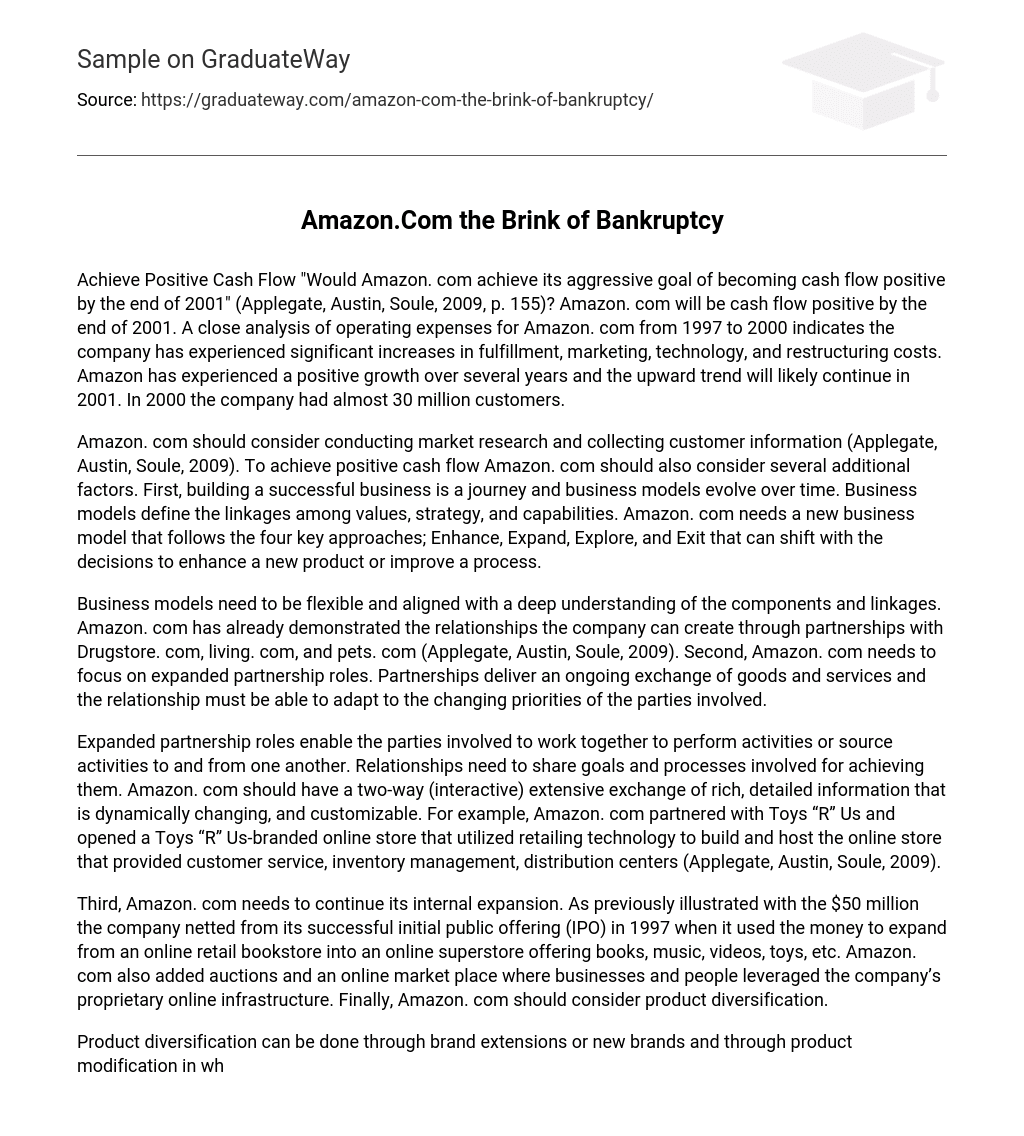Achieve Positive Cash Flow “Would Amazon. com achieve its aggressive goal of becoming cash flow positive by the end of 2001” (Applegate, Austin, Soule, 2009, p. 155)? Amazon. com will be cash flow positive by the end of 2001. A close analysis of operating expenses for Amazon. com from 1997 to 2000 indicates the company has experienced significant increases in fulfillment, marketing, technology, and restructuring costs. Amazon has experienced a positive growth over several years and the upward trend will likely continue in 2001. In 2000 the company had almost 30 million customers.
Amazon. com should consider conducting market research and collecting customer information (Applegate, Austin, Soule, 2009). To achieve positive cash flow Amazon. com should also consider several additional factors. First, building a successful business is a journey and business models evolve over time. Business models define the linkages among values, strategy, and capabilities. Amazon. com needs a new business model that follows the four key approaches; Enhance, Expand, Explore, and Exit that can shift with the decisions to enhance a new product or improve a process.
Business models need to be flexible and aligned with a deep understanding of the components and linkages. Amazon. com has already demonstrated the relationships the company can create through partnerships with Drugstore. com, living. com, and pets. com (Applegate, Austin, Soule, 2009). Second, Amazon. com needs to focus on expanded partnership roles. Partnerships deliver an ongoing exchange of goods and services and the relationship must be able to adapt to the changing priorities of the parties involved.
Expanded partnership roles enable the parties involved to work together to perform activities or source activities to and from one another. Relationships need to share goals and processes involved for achieving them. Amazon. com should have a two-way (interactive) extensive exchange of rich, detailed information that is dynamically changing, and customizable. For example, Amazon. com partnered with Toys “R” Us and opened a Toys “R” Us-branded online store that utilized retailing technology to build and host the online store that provided customer service, inventory management, distribution centers (Applegate, Austin, Soule, 2009).
Third, Amazon. com needs to continue its internal expansion. As previously illustrated with the $50 million the company netted from its successful initial public offering (IPO) in 1997 when it used the money to expand from an online retail bookstore into an online superstore offering books, music, videos, toys, etc. Amazon. com also added auctions and an online market place where businesses and people leveraged the company’s proprietary online infrastructure. Finally, Amazon. com should consider product diversification.
Product diversification can be done through brand extensions or new brands and through product modification in which a new market is created by creating new uses for specific products (Applegate, Austin, Soule, 2009). Question 2 – Poised for Exponential Growth “Was it poised for exponential growth in revenues, profits, and returns to investors” (Applegate, et al. , 2009, p. 155)? Amazon. com will experience exponential growth. The 2005 U. S. market estimates (exhibit 3) that existing product categories will grow significantly. Company executives believe that Amazon. om has reached a “tipping point” that will enable exponential growth and return to investors. Amazon. com creates a virtuous cycle effect.
The cycle rotates through value, strategy, and capabilities over and over again. Amazon. com focuses on cost reduction which leads to lower prices which leads to more customers which then leads to lower cost per units sold. The cycle generates revenue and drives efficiency creating profit and growth which drives investor confidence increasing market value (Applegate, Austin, Soule, 2009). Bezos explored ways for Amazon. com to use their brand and maximize capabilities in order to avoid the 2000 dot. om market crash. Amazon. com spent over $400 million on digital business infrastructure that linked nine distribution centers and six customer service centers throughout the U. S. , Europe, and Asia during 1998 and 1999.
Due to the company’s larger customer base from expansion with the infrastructure in place Amazon. com will earn profits quickly. The digital business infrastructure allowed Amazon. com to cut their cost drastically because they did not have to stock every item. Customers received shipments faster which increased customer loyalty and satisfaction.
IT capabilities enabled Amazon. com to cut cost, earn higher profits, and reduce competition by gaining partnerships (Applegate, Austin, Soule, 2009). Questions 3 and 4 – Time Requirements “How much time did the company have and how much time would it need to spend to prove that it could create and sustain value over time” (Applegate, et al. , 2009, p. 155)? Amazon. com had 5 years since the company went public in 1995 and needed 1 year to create and sustain value over time. Many of the investments have been made to build the state-of-the art digital business infrastructure.
The company has tremendous opportunities according to the SWOT analysis. Amazon. com is ranked 48th worldwide and online retail sales are growing rapidly. Amazon. com has good leadership and digital infrastructure with excess capacity. Amazon. com has built high barriers to entry and is the leading online retailer globally and has a large customer base with many loyal repeat buyers (Applegate, Austin, Soule, 2009). Bezos invested millions of dollars in IT to reach a wide range of customers and to develop a unique business infrastructure.
The platform for Amazon. om is comprised of brand, technology, distribution capability, customers, and a great team that has a passion for serving customers well and for innovation. The business model and strategies used are successful for Amazon. com as indicated by the increase in net income in the fourth financial quarter figures. Bezos is the key behind the success of Amazon. com (Applegate, Austin, Soule, 2009).
References
- Applegate, L. M. , Austin, R. D. , & Soule, D. L. (2009). Corporate information strategy and management: Text and cases. (8th ed. ). Boston: McGraw-Hill.





